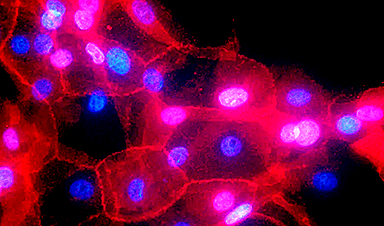The new findings have the potential to improve our understanding of cancers and a multitude of other diseases.
Researchers at La Jolla Institute for Immunology (LJI) have finally discovered the role of an enzyme named O-GlcNAc transferase (OGT) in maintaining cell health. The findings, which were published in the Proceedings of the National Academies of Sciences, offer crucial insights into cellular biology and could pave the way for significant medical breakthroughs.
"Many diseases are related to OGT function," says LJI Instructor Xiang Li, Ph.D., who served as the first author for the new study. "For example, many studies have shown abnormal OGT function in cancer, diabetes, and cardiovascular disease."
The new study, spearheaded by Li and co-led by LJI Professor Anjana Rao, Ph.D., and LJI Assistant Professor Samuel Myers, Ph.D., is the first to show that OGT controls cell survival by regulating a critical protein called mTOR.
"OGT is important for every cell in the body," explains Myers. "Thanks to this research, we now have a model we can use for future studies into what each part of OGT does."
The one and only OGT
OGT is an enzyme called a transferase. This type of enzyme carries out a job called glycosylation, where sugar molecules are added to recently synthesized proteins. OGT is unique among transferases because it modifies proteins within cells, rather than proteins on the cell surface or secreted proteins.
In fact, OGT's job of glycosylation is so important that embryonic cells will die without it. But until now, scientists were in the dark as to why.
As Myers explains, the essential nature of OGT is what makes it so hard to study. Scientists usually study enzymes and other proteins by developing cells that lack the genes for those proteins. They generate the new, dysfunctional cells and then investigate how things have gone wrong.
But with OGT, that kind of experiment would be over before it even began. Because there is only one OGT, scientists haven't been able to delete it or reduce its function without simply killing the very cells they need to study. "We knew OGT was essential for cell survival, but for more than 20 years we didn't know why," says Li.
For the new study, Li was able to get around that problem by using an inducible system to delete the OGT gene. He worked with mouse embryonic stem cells and then used an inducible version of a protein known as Cre to delete the gene for OGT. This meant that the cells could grow normally until the scientists decided to activate the process, after which cells that had lost the OGT gene began to stop proliferating and die.
The team found that deleting the gene for OGT led to an abnormal increase in the function of a key enzyme called mTOR that regulates cell metabolism. Deleting the gene for OGT also fueled an essential but potentially dangerous process in cells called mitochondrial oxidative phosphorylation.
Why is mitochondrial oxidative phosphorylation so dangerous? This process in cells is part of a delicate pathway that allows cells to produce ATP (the molecule that powers a cell). ATP can be produced by glycolysis as well as by mitochondrial oxidative phosphorylation, and disturbing this balance can have devastating consequences for cells.
Fortunately, OGT safeguards mTOR activity and mitochondrial fitness by keeping protein synthesis running smoothly and regulating amino acid levels within cells. Importantly, the researchers discovered the same protective role for OGT in CD8+ T cells, which suggests the enzyme works the same way across mammalian cell types, not just in mouse embryonic stem cells.
Researchers to the rescue
Even the dysfunctional cells lacking OGT weren't doomed forever. The scientists were able to "rescue" the dysfunctional cells using a new cutting-edge technology for gene editing called CRISPR/Cas9.
By asking whether a second gene in the mouse embryonic stem cells would restore the growth of cells lacking OGT, Li found that mTOR and mitochondrial oxidative phosphorylation were hyperactivated in cells lacking OGT, and the cells could be rescued by damping down their function.
This is good news for scientists hoping to learn more about OGT's role in the body. "Now that we can delete the gene for OGT while keeping cells alive, we can try restoring just pieces of OGT to learn more about how OGT works to keep cells alive," says Myers.
Li says his new discovery may allow researchers to further study the role of OGT and potentially find therapeutic targets to counteract abnormal activity. "In the future, we hope our research could help shed light on issues related to dysfunctional OGT in cancer and other diseases," Li says.
News
Two New Books From Frank Boehm, NA Founder – To be Released Dec. 2025
Molecular Manufacturing: The Future of Nanomedicine This book explores the revolutionary potential of atomically precise manufacturing technologies to transform global healthcare, as well as practically every other sector across society. This forward-thinking volume examines [...]
What could the future of nanoscience look like?
Society has a lot to thank for nanoscience. From improved health monitoring to reducing the size of electronics, scientists’ ability to delve deeper and better understand chemistry at the nanoscale has opened up numerous [...]
Scientists Melt Cancer’s Hidden “Power Hubs” and Stop Tumor Growth
Researchers discovered that in a rare kidney cancer, RNA builds droplet-like hubs that act as growth control centers inside tumor cells. By engineering a molecular switch to dissolve these hubs, they were able to halt cancer [...]
Platelet-inspired nanoparticles could improve treatment of inflammatory diseases
Scientists have developed platelet-inspired nanoparticles that deliver anti-inflammatory drugs directly to brain-computer interface implants, doubling their effectiveness. Scientists have found a way to improve the performance of brain-computer interface (BCI) electrodes by delivering anti-inflammatory drugs directly [...]
After 150 years, a new chapter in cancer therapy is finally beginning
For decades, researchers have been looking for ways to destroy cancer cells in a targeted manner without further weakening the body. But for many patients whose immune system is severely impaired by chemotherapy or radiation, [...]
Older chemical libraries show promise for fighting resistant strains of COVID-19 virus
SARS‑CoV‑2, the virus that causes COVID-19, continues to mutate, with some newer strains becoming less responsive to current antiviral treatments like Paxlovid. Now, University of California San Diego scientists and an international team of [...]
Lower doses of immunotherapy for skin cancer give better results, study suggests
According to a new study, lower doses of approved immunotherapy for malignant melanoma can give better results against tumors, while reducing side effects. This is reported by researchers at Karolinska Institutet in the Journal of the National [...]
Researchers highlight five pathways through which microplastics can harm the brain
Microplastics could be fueling neurodegenerative diseases like Alzheimer's and Parkinson's, with a new study highlighting five ways microplastics can trigger inflammation and damage in the brain. More than 57 million people live with dementia, [...]
Tiny Metal Nanodots Obliterate Cancer Cells While Largely Sparing Healthy Tissue
Scientists have developed tiny metal-oxide particles that push cancer cells past their stress limits while sparing healthy tissue. An international team led by RMIT University has developed tiny particles called nanodots, crafted from a metallic compound, [...]
Gold Nanoclusters Could Supercharge Quantum Computers
Researchers found that gold “super atoms” can behave like the atoms in top-tier quantum systems—only far easier to scale. These tiny clusters can be customized at the molecular level, offering a powerful, tunable foundation [...]
A single shot of HPV vaccine may be enough to fight cervical cancer, study finds
WASHINGTON -- A single HPV vaccination appears just as effective as two doses at preventing the viral infection that causes cervical cancer, researchers reported Wednesday. HPV, or human papillomavirus, is very common and spread [...]
New technique overcomes technological barrier in 3D brain imaging
Scientists at the Swiss Light Source SLS have succeeded in mapping a piece of brain tissue in 3D at unprecedented resolution using X-rays, non-destructively. The breakthrough overcomes a long-standing technological barrier that had limited [...]
Scientists Uncover Hidden Blood Pattern in Long COVID
Researchers found persistent microclot and NET structures in Long COVID blood that may explain long-lasting symptoms. Researchers examining Long COVID have identified a structural connection between circulating microclots and neutrophil extracellular traps (NETs). The [...]
This Cellular Trick Helps Cancer Spread, but Could Also Stop It
Groups of normal cbiells can sense far into their surroundings, helping explain cancer cell migration. Understanding this ability could lead to new ways to limit tumor spread. The tale of the princess and the [...]
New mRNA therapy targets drug-resistant pneumonia
Bacteria that multiply on surfaces are a major headache in health care when they gain a foothold on, for example, implants or in catheters. Researchers at Chalmers University of Technology in Sweden have found [...]
Current Heart Health Guidelines Are Failing To Catch a Deadly Genetic Killer
New research reveals that standard screening misses most people with a common inherited cholesterol disorder. A Mayo Clinic study reports that current genetic screening guidelines overlook most people who have familial hypercholesterolemia, an inherited disorder that [...]





















